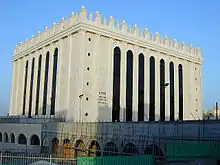Jewish architecture comprises the architecture of Jewish religious buildings and other buildings that either incorporate Jewish elements in their design or are used by Jewish communities.

Oriental style—Belz Great Synagogue (2000), Jerusalem.
Terminology
Due to the diasporic nature of Jewish history, there is no single architectural style that is common across all Jewish cultures.[1] Examples of buildings considered Jewish architecture include explicitly religious buildings such as synagogues and mikvehs,[2] as well as Jewish schools.[3]
See also
References
- ↑ Prager, Brad (2013). "Building After Auschwitz: Jewish Architecture and the Memory of the Holocaust by Gavriel D. Rosenfeld (review)". German Studies Review. 36 (3): 727–728. doi:10.1353/gsr.2013.0122. ISSN 2164-8646. S2CID 161345397.
- ↑ Leslie, Thomas (2011). "Review of Louis I. Kahn's Jewish Architecture: Mikveh Israel and the Midcentury American Synagogue". Shofar. 29 (2): 222–224. ISSN 0882-8539. JSTOR 10.5703/shofar.29.2.222.
- ↑ Kastner, Eitan (2010). "Yeshiva College and the Pursuit of a Jewish Architecture". American Jewish History. 96 (2): 141–161. doi:10.1353/ajh.2010.0021. ISSN 1086-3141. S2CID 162261984.
This article is issued from Wikipedia. The text is licensed under Creative Commons - Attribution - Sharealike. Additional terms may apply for the media files.